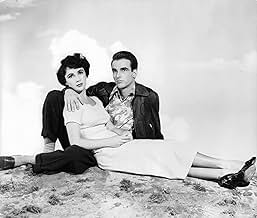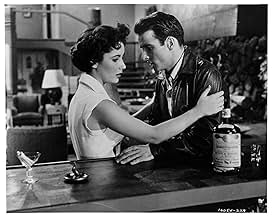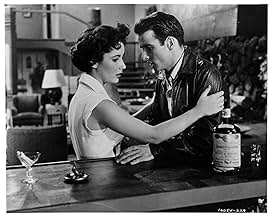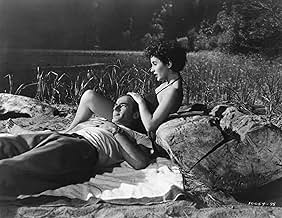NOTE IMDb
7,7/10
26 k
MA NOTE
Un pauvre jeune garçon travaille pour son riche oncle riche et finit par tomber amoureux de deux femmes.Un pauvre jeune garçon travaille pour son riche oncle riche et finit par tomber amoureux de deux femmes.Un pauvre jeune garçon travaille pour son riche oncle riche et finit par tomber amoureux de deux femmes.
- Réalisation
- Scénario
- Casting principal
- Récompensé par 6 Oscars
- 18 victoires et 12 nominations au total
Robert J. Anderson
- Eagle Scout
- (non crédité)
Gertrude Astor
- Bit Part
- (non crédité)
Avis à la une
George Stevens' A PLACE IN THE SUN is a poetic film, filled with tender moments, sadness, and pending doom. Having not read the book, I had the pleasure of seeing the material for the first time, which is preferable if you see a film based on a "classic" novel. Montgomery Clift is his usual mysterious self as he has a scandalous relationship with the homely Shelly Winters and falls instantly in love with a spellbindingly beautiful Liz Taylor, who was only 19 when the picture was made. She glows with energy and a sense of optimism about life, a stark contrast to Clift, whom Taylor has also fallen for. Rumor has it they had an actual affair while making the movie. This is not for all tastes, for it is slow, and Clift is not all that appealing. The idea of dropping a lesser life (with Winters) and pursuing the good life with Taylor is what makes it work and the lengths to which Clift will go are staggering.
George Stevens has a gift for "painting" a movie on-screen. Just see GIANT, also with Taylor, or SHANE, the other two parts of his "American Trilogy". The scenes on the lake and the way the mood of the movie is painted is quite simply amazing. He also uses slow dissolves that leave a ghostly image on-screen between scenes. This all adds to the atmospheric touch of tragedy that will ensue. Poor Shelly Winters. She always gets a raw deal in films. There are times when you almost sympathize with Clift. Imagine living the life of a socialite with the girl of your dreams and a good job with your family. A life with Winters would be dismal according to Clift and us. What's right is right, however. An unnecessary court room saga closes the picture to ensure the viewer's sense of justice. This must've been pretty controversial stuff back in the early-50's
A PLACE IN THE SUN truly is an American tragedy, a portrait of young lives gone wrong with post-WWII optimism as a backdrop. Clift and Taylor shine together, and provide film fans with a romance never to be forgotten. The finale is emotionally draining during Taylor's expression of undying love. Unfortunately, Clift cannot have it all. A beautiful piece of classical Hollywood film-making with a mix of method acting (Clift) and a love story we wish could work.
RATING: 8 of 10
George Stevens has a gift for "painting" a movie on-screen. Just see GIANT, also with Taylor, or SHANE, the other two parts of his "American Trilogy". The scenes on the lake and the way the mood of the movie is painted is quite simply amazing. He also uses slow dissolves that leave a ghostly image on-screen between scenes. This all adds to the atmospheric touch of tragedy that will ensue. Poor Shelly Winters. She always gets a raw deal in films. There are times when you almost sympathize with Clift. Imagine living the life of a socialite with the girl of your dreams and a good job with your family. A life with Winters would be dismal according to Clift and us. What's right is right, however. An unnecessary court room saga closes the picture to ensure the viewer's sense of justice. This must've been pretty controversial stuff back in the early-50's
A PLACE IN THE SUN truly is an American tragedy, a portrait of young lives gone wrong with post-WWII optimism as a backdrop. Clift and Taylor shine together, and provide film fans with a romance never to be forgotten. The finale is emotionally draining during Taylor's expression of undying love. Unfortunately, Clift cannot have it all. A beautiful piece of classical Hollywood film-making with a mix of method acting (Clift) and a love story we wish could work.
RATING: 8 of 10
Poor and uneducated George Eastman (Montgomery Clift) unwittingly sets a trap for himself when he takes an entry-level job at his rich uncle's factory, which has a prohibition on male employees dating female employees. He just can't resist one of the girls in his department, the pitiful and whiny Alice Tripp (wonderfully played by Shelley Winters). Eventually, George gets a promotion and is invited into the upper echelon of his uncle's social world, where he meets wealthy and beautiful Angela Vickers (a breathless Elizabeth Taylor). Naturally, he falls in love with Angela. But a complication with Alice leaves him unable to break off his relationship with her.
That's the setup for this George Stevens-directed film that plays rather like a modern Greek tragedy. Everything about "A Place In The Sun" is high quality: the production design, the lavish Edith Head costumes, the wonderful editing, and that great B&W cinematography with those marvelous close-up shots, and overlapping dissolves that cleverly advance the plot.
All three principal actors do a splendid job. And they get solid support from a top notch secondary cast that includes Raymond Burr and the interesting Anne Revere.
The story clearly plays up social class differences, with the haughty rich looking down their noses at common workers. The film's tone varies from romantic, to sad, to suspenseful. At mysterious Loon Lake where significant events occur, the cinematic atmosphere is heavy with anticipation. It's like something out of a Hitchcock thriller.
I've never cared much for sad love stories, and the film does seem a tad dated. Still, it's so well made it can be appreciated by most everyone but the terminally shallow. It has a powerful ending, one that accentuates the acting accomplishments of Clift and especially of Taylor. "A Place In The Sun" was nominated for nine academy awards, and winner of six. I'd say this is one time when Oscar voters got it right.
That's the setup for this George Stevens-directed film that plays rather like a modern Greek tragedy. Everything about "A Place In The Sun" is high quality: the production design, the lavish Edith Head costumes, the wonderful editing, and that great B&W cinematography with those marvelous close-up shots, and overlapping dissolves that cleverly advance the plot.
All three principal actors do a splendid job. And they get solid support from a top notch secondary cast that includes Raymond Burr and the interesting Anne Revere.
The story clearly plays up social class differences, with the haughty rich looking down their noses at common workers. The film's tone varies from romantic, to sad, to suspenseful. At mysterious Loon Lake where significant events occur, the cinematic atmosphere is heavy with anticipation. It's like something out of a Hitchcock thriller.
I've never cared much for sad love stories, and the film does seem a tad dated. Still, it's so well made it can be appreciated by most everyone but the terminally shallow. It has a powerful ending, one that accentuates the acting accomplishments of Clift and especially of Taylor. "A Place In The Sun" was nominated for nine academy awards, and winner of six. I'd say this is one time when Oscar voters got it right.
10bmacv
Bringing Theodore Dreiser's sprawling novel An American Tragedy to the screen must have been a daunting task, made harder by the constraints Paramount imposed on director George Stevens. The studio had lost big on a version made 20 years earlier, under Josef von Sternberg, and had little faith in a remake. So, hobbled by a tight budget, Stevens scaled back his ambitious plans but delivered, perhaps even to his own surprise, a superbly crafted and and powerfully sustained work of movie art.
He was lucky that Paramount, edgy about the story, gave him a cast that would guarantee not only good box office but solid performances as well. Montgomery Clift, Elizabeth Taylor and Shelly Winters take the principal roles, with, in the last third of the movie, extra oomph courtesy of Raymond Burr (in a role that may have nabbed him the Perry Mason franchise).
The jaws of the vise Clift finds himself squeezed into are class and sex. Barely educated, raised by stern members of a religious sect, he luckily (or not) happens to be the shirt-tail nephew of a prosperous entrepreneur who casually offers him work in his factory. Awkward and lonesome, Clift escapes the drudgery of his job by taking up with a mousy co-worker (Winters, toned way down from her platinum-bombshell image at the time). But his nose-to-the-grindstone ways attract the attention of his uncle, who rewards him with a promotion and an invitation up to the manor.
There he meets Taylor and launches an obsession about her, reinforced by a neon sign visible from his window that blazes her surname through his restless nights (she's another child of an industrial fortune, raised in wealth and privilege). Somehow, she falls for him and, need it be added, he for her despite his coming from the wrong side of the tracks (she hasn't the faintest notion that for people like him, life may not be the blithe affair it is for her).
Only one inconvenient fact keeps Clift from taking his rightful place in the sun: He's left Winters pregnant. The two worlds he occupies are destined to collide, and crash they do when Winters phones him, in the midst of a Hawaiian-themed luau at Taylor's summer place on the lake, to issue her ultimatum: Marry her or she'll spill their sordid secret. He leaves abruptly to meet Winters, desperately trying to assemble the plan which will seal three fates.
Stevens sustains an overwhelming, ominous momentum, unbroken by even a hint of levity (not even a single bit player is allowed to lapse into shtik). Languorous dissolves and superimposed images heighten the sense of inevitability as each scene, each event glides seamlessly into the next.
Maybe he wasn't able to pile on the exhaustive social commentary that bulked up Dreiser's novel, but everywhere there's sharp detail that he adroitly leaves to be noticed. When Clift shows up hours late at his intimate birthday party in Winter's cramped room, with the tiny table pushed up against her marble washstand, the ice cream has warmed to lumpy syrup (a self-homage to a similar scene in Steven's Alice Adams?). With an island combo playing merrily on, Clift sports a lei and eats pineapple out of its shell when Winters calls to break the spell and this South-Seas reverie is offered up not as Veblenesque excess, but merely as the way Taylor's crowd spend their days and evenings and nights in an endless round of heedless gaiety.
The apex of the film's crescendo is handled with tight, quiet assurance the reckoning in a rowboat upon a deserted lake. Dusk gathers among the pines like fog, the loons call back and forth, and the rippling waves reflect a demented flash into Clift's eye as he wrestles with his conscience. Winters natters nervously about the dreary life they'll spend together while his head swims with luminous visions of Taylor. Then, destiny catches.... Romantic but unsentimental, serious but without pretension, gripping without stooping to the manipulative, A Place in the Sun ranks as a masterpiece of American cinema.
He was lucky that Paramount, edgy about the story, gave him a cast that would guarantee not only good box office but solid performances as well. Montgomery Clift, Elizabeth Taylor and Shelly Winters take the principal roles, with, in the last third of the movie, extra oomph courtesy of Raymond Burr (in a role that may have nabbed him the Perry Mason franchise).
The jaws of the vise Clift finds himself squeezed into are class and sex. Barely educated, raised by stern members of a religious sect, he luckily (or not) happens to be the shirt-tail nephew of a prosperous entrepreneur who casually offers him work in his factory. Awkward and lonesome, Clift escapes the drudgery of his job by taking up with a mousy co-worker (Winters, toned way down from her platinum-bombshell image at the time). But his nose-to-the-grindstone ways attract the attention of his uncle, who rewards him with a promotion and an invitation up to the manor.
There he meets Taylor and launches an obsession about her, reinforced by a neon sign visible from his window that blazes her surname through his restless nights (she's another child of an industrial fortune, raised in wealth and privilege). Somehow, she falls for him and, need it be added, he for her despite his coming from the wrong side of the tracks (she hasn't the faintest notion that for people like him, life may not be the blithe affair it is for her).
Only one inconvenient fact keeps Clift from taking his rightful place in the sun: He's left Winters pregnant. The two worlds he occupies are destined to collide, and crash they do when Winters phones him, in the midst of a Hawaiian-themed luau at Taylor's summer place on the lake, to issue her ultimatum: Marry her or she'll spill their sordid secret. He leaves abruptly to meet Winters, desperately trying to assemble the plan which will seal three fates.
Stevens sustains an overwhelming, ominous momentum, unbroken by even a hint of levity (not even a single bit player is allowed to lapse into shtik). Languorous dissolves and superimposed images heighten the sense of inevitability as each scene, each event glides seamlessly into the next.
Maybe he wasn't able to pile on the exhaustive social commentary that bulked up Dreiser's novel, but everywhere there's sharp detail that he adroitly leaves to be noticed. When Clift shows up hours late at his intimate birthday party in Winter's cramped room, with the tiny table pushed up against her marble washstand, the ice cream has warmed to lumpy syrup (a self-homage to a similar scene in Steven's Alice Adams?). With an island combo playing merrily on, Clift sports a lei and eats pineapple out of its shell when Winters calls to break the spell and this South-Seas reverie is offered up not as Veblenesque excess, but merely as the way Taylor's crowd spend their days and evenings and nights in an endless round of heedless gaiety.
The apex of the film's crescendo is handled with tight, quiet assurance the reckoning in a rowboat upon a deserted lake. Dusk gathers among the pines like fog, the loons call back and forth, and the rippling waves reflect a demented flash into Clift's eye as he wrestles with his conscience. Winters natters nervously about the dreary life they'll spend together while his head swims with luminous visions of Taylor. Then, destiny catches.... Romantic but unsentimental, serious but without pretension, gripping without stooping to the manipulative, A Place in the Sun ranks as a masterpiece of American cinema.
This 1950s melodrama was an interesting, involving story. It's part film-noir, too, which I liked. I say that because the last third of the film featured an expectation of some dreaded act about to be committed, giving it a film noir feel.
One thing for sure, whatever you label the movie: it's well-acted, well-directed and well-photographed. Regarding the latter, this really looks good on DVD. No surprise it's directed well since George Stevens was the director. His resume speaks for itself.
Obviously Montgomery Clift and Elizabeth Taylor are the "big names" in this film, but I found Shelly Winters and the character she played to be the most intriguing. She wasn't really appealing yet one could certainly identify with her feelings of insecurity with Taylor as her competition. "Liz" was in in her prime, looks-wise, with an absolutely classic face.
Anyway, watching the character studies of the antsy Winters and the troublesome Clift were interesting. Clift, as is the case with most of us, causes his own problems and things slowly unravel for him. The story is another example of what can happen when one tries to cover up the truth. It comes back to bite you, big-time!
I really found it refreshing, however, to see Clift's attitude at the end. It's the exact opposite of what you hear today. He actually takes responsibility for his actions.
One thing for sure, whatever you label the movie: it's well-acted, well-directed and well-photographed. Regarding the latter, this really looks good on DVD. No surprise it's directed well since George Stevens was the director. His resume speaks for itself.
Obviously Montgomery Clift and Elizabeth Taylor are the "big names" in this film, but I found Shelly Winters and the character she played to be the most intriguing. She wasn't really appealing yet one could certainly identify with her feelings of insecurity with Taylor as her competition. "Liz" was in in her prime, looks-wise, with an absolutely classic face.
Anyway, watching the character studies of the antsy Winters and the troublesome Clift were interesting. Clift, as is the case with most of us, causes his own problems and things slowly unravel for him. The story is another example of what can happen when one tries to cover up the truth. It comes back to bite you, big-time!
I really found it refreshing, however, to see Clift's attitude at the end. It's the exact opposite of what you hear today. He actually takes responsibility for his actions.
Time does extraordinary things with greatness. If nothing else it confirms it. "A Place in the Sun" is a remarkable example of that theory. I rushed to buy a DVD after watching a BBC documentary on ELizabeth Taylor to celebrate her 75th birthday! In "A Place on the Sun" an Elizabeth Taylor barely out of her teens is paired with Montgomery Clift. She had been raised at MGM and groomed for movie stardom from day one. He was a method actor, complex, introspective and their coupling produced something that I'm tempted to call, unrepeatable. The actors own personal stories, their friendship, mutual love and respect made it possible for their communion to be so transcendental. To make things even more perfect, the film seems a love letter from director George Stevens to his stars and vice versa. Look at the opening credits and tell me if you've ever seen a more startling introduction to a character/star. The story of doomed love and descend into darkness is, without question, one of the best ever made.
Le saviez-vous
- AnecdotesIn her autobiography, Shelley Winters described producer and director George Stevens' way of working: "He would discuss the scene, but not the lines, and would photograph the second or third rehearsal so the scene had an almost improvisatory quality. Stevens would print the first take, then spend the next three hours minutely rehearsing the scene, then film it again. He explained to me that in this way he often got actors' unplanned reactions that were spontaneous and human and often exactly right. And often when actors overintellectualize or plan their reactions, they aren't as good."
- GaffesAlice Tripp is wearing different shoes when she starts walking home from the movie with George Eastman from those she is wearing when they near her residence. When Shelley Winters pointed out to director George Stevens that the brown and white shoes she was wearing turned to black when she walked around the corner, the director refused to re-shoot the scene. According to Winters, he said, "If they're looking at her feet, I can go home."
- ConnexionsFeatured in Hollywood: The Fabulous Era (1962)
Meilleurs choix
Connectez-vous pour évaluer et suivre la liste de favoris afin de recevoir des recommandations personnalisées
Détails
Box-office
- Budget
- 2 295 304 $US (estimé)
- Montant brut mondial
- 18 247 $US
- Durée2 heures 2 minutes
- Couleur
- Rapport de forme
- 1.37 : 1
Contribuer à cette page
Suggérer une modification ou ajouter du contenu manquant

Lacune principale
By what name was Une place au soleil (1951) officially released in India in English?
Répondre





































